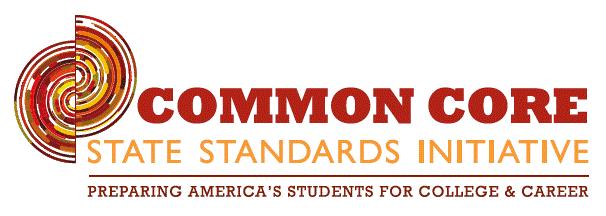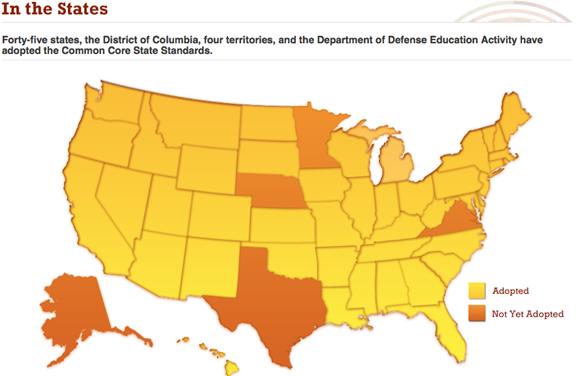
Common Core Standards

Mission Statement:
The Common Core State Standards provide a consistent, clear understanding of what students are expected to learn, so teachers and parents know what they need to do to help them. The standards are designed to be robust and relevant to the real world, reflecting the knowledge and skills that our young people need for success in college and careers. With American students fully prepared for the future, our communities will be best positioned to compete successfully in the global economy.
What are the Common Core State Standards?
The Common Core State Standards (CCSS) are a set of sequential benchmarks to show what a child needs to have learned and be able to do by the end of each grade. The standards build on one another like a pyramid, starting with an emphasis on developing strong foundational skills, and moving up with each grade level. The ultimate goal is for each student to graduate ready and able to move on to college or into a career. Currently, 45 states and the District of Columbia have adopted the Common Core.
Who developed these standards and why?
Who: Educators from 48 states worked together to create a uniform set of expectations for all students. The standards were developed by a partnership with the states, teachers, school administrators, education experts, parents, and business leaders from around the country. The Council of Chief State School Officers and the National Governors Association Center for Best Practices coordinated the effort. In addition, the draft standards were subject to public comment and input.
Why: The Common Core provides thorough, relevant, and consistent guidelines for learning. The standards focus on the skills and knowledge needed to succeed in the real world and thrive in the global workforce.
Which grades and subjects to the standards cover?
The Common Core addresses K-12 for math and English Language Arts. Mathematics and English Language Arts were selected because other content areas build on the skills learned in those disciplines. Standards in science are in process, and it is anticipated that standards for other subject areas will follow.
English Language Arts
The Common Core State Standards for English Language Arts are divided into sections for K-5 and 6-12. The standards for all grades fall into the following domains, or groups of related standards:
- Reading: covers analysis and understanding of literature and informational text
- Writing: deals with persuasive, narrative, and expository writing; organization; and research
- Speaking and Listening: focuses on comprehension, presentations, and working with others
- Language: includes grammar, usage, punctuation, vocabulary, and other conventions of language
Elementary Grades: K-5
The standards for younger students focus on developing comprehension strategies, or different ways to understand what they read. The goal for kindergarten through grade 5 is to help students become independent readers and writers who think critically about literature. This way, students build a solid foundation for middle and high school.
Students will:
- develop basic foundational skills in using written and spoken language in kindergarten
- learn how to read and think critically about informational text, such as newspapers, maps, and charts
- become effective communicators
- discover how to present their knowledge and converse with other in a respectful way
- understand the basics of how to use language properly, in both speaking and writing
These skills will lay the groundwork for students to convey their ideas well in later grades.
Middle Grades: 6-8
Middle school students are expected to look even deeper into what they’re reading, and to use what they learn about structure and literary elements in their writing:
They will:
- become familiar with different types of text, such as modern fiction, non-fiction, myths, and plays
- explore texts in different media, including digital text and video
- learn more about elements of literature, such as irony
- analyze text for meaning, bias, and other complex elements
- learn how to conduct research projects, build persuasive arguments, and present their findings to others
- continue to develop grammar and expand vocabulary
Text recommended under the Common Core State Standards may be more complex than what was used under old state standards.
Shifts for Students Demanded by the Common Core in English Language Arts:
Below are shifts for students in the areas of English Language Arts/Literacy.
English Language Arts
- Read as much non-fiction as fiction
- Learn about the world by reading
- Read more challenging material closely
- Discuss reading using evidence
- Write non-fiction using evidence
- Increase academic vocabulary
ELA/Literacy Shift 1: Read as much non-fiction as fiction
Students must…
- Read more non-fiction
- Know the ways non-fiction can be put together
- Enjoy and discuss the details of non-fiction
Parents can…
- Supply more non-fiction text
- Read non-fiction texts aloud or with your child
- Have fun with non-fiction in front of your children
ELA/Literacy Shift 2: Learn about the world by reading
Students must…
- Get smart in science and social studies through reading
- Handle “primary source” documents
- Get smarter through texts
Parents can…
- Supply series of texts on topics of interest
- Find books that explain
- Discuss non-fiction texts and the ideas within
ELA/Literacy Shift 3: Read more complex material carefully
Students must…
- Reread
- Read material at comfort level AND work with more challenging stuff
- Handle frustration and keep pushing
Parents can…
- Provide more challenging texts AND provide text children WANT to read and can read comfortably
- Know what is grade level appropriate
- Show that challenging stuff is worth unpacking
ELA/Literacy Shift 4: Discuss reading using evidence
Students must…
- Find evidence to support their arguments
- Form judgments
- Discuss what the author is “up to”
Parents can…
- Talk about text
- Demand evidence in every day discussions/disagreements
- Read aloud or read the same book and discuss with evidence
ELA/Literacy Shift 5: Writing from Sources
Students must…
- Make arguments in writing using evidence
- Compare multiple texts in writing
- Write well
Parents can…
- Encourage writing at home
- Write “books” together and use evidence/details
- Look at Appendix C.
ELA/Literacy Shift 6: Academic Vocabulary
Students must…
- Learn the words that they can use in college and career
- Get smarter at using the “language of power”
Parents can…
- Read often and constantly with babies, toddlers, preschoolers, and children
- Read multiple books about the same topic
- Let your kids see you reading
- Talk to your children; read to your children; listen to your children; sing with your children; make up silly rhymes and word games with your children
Mathematics
The Common Core State Standards for math are divided into content standards and practice standards. Content standards address the mathematical topics/content at each grade level. Practice standards address the skills that are needed in thinking about and solving problems. These practices emphsize the importance of perseverence, the use of appropriate tools, and reasoning.
Mathematics Practice Standards
The Common Core standards include a list of Mathematical Practices. The Mathematical Practices aren’t standards; they are common sense skills for how to think about and solve problems. They are intended to complement the standards. The Mathematical Practices are based on long-standing evidence and research into how students develop math expertise. These Mathematical Practices emphasize the importance of perseverance, the use of appropriate tools, and reasoning. These skills will be important to students in their education and in their careers. In all grades, teachers will help students develop these skills as they work to master the CCSS.
Common Core Standards for Mathematical Practice
- Make sense of problems and persevere in solving them.
- Reason abstractly and quantitatively.
- Construct viable arguments and critique the reasoning of others.
- Model with mathematics.
- Use appropriate tools strategically.
- Attend to precision.
- Look for and make use of structure.
- Look for and express regularity in repeated reasoning.
Math Content Standards
The Common Core standards for math are divided into sections for lower, middle, and higher grades. Groups of related standards are called domains. The following lists describe the domains for kindergarten through grade 8 under the CCSS.
Elementary Grades: K-5
Kindergarten
Standards introduciing number and operation in base ten appear in kindergarten. Students will work with numbers 11-19 to start to understand place value. Standards introducing basic algebraic thinking skills—not problems with variables—appear in kindergarten.
New Common Core Domains:
- Counting and Cadinality
- Operations and Algebraic Thinking
- Number and Operations in Base Ten
- Measurement and Data
- Geometry
Grades 1-2
Notice the continuing focus on algebraic thinking.
New Common Core Domains:
- Operations and Algebraic Thinking
- Number and Operations in Base Ten
- Measurement and Data
- Geometry
Grades 3-5
Note the greater emphasis on number and operations in these grades.
New Common Core Domains:
- Operations and Algebraic Thinking
- Number and Operations in Base Ten
- Number and Operations—Fractions
- Measurement and Data
- Geometry
Middle Grades: 6-8
In middle grades, the CCSS address the following domains.
Grades 6-7
Students in grades 6 and 7 will see an emphasis on algebraic concepts such as proportional relationships, expressions, and equations.
New Common Core Domains:
- Ratios and Proportional Relationships
- The Number System
- Expressions and Equations
- Geometry
- Statistics and Probability
Grade 8
This grade will continue to focus on algebraic concepts such as expressions, equations, and functions.
New Common Core Domains:
- The Number System
- Expressions and Equations
- Functions
- Geometry
- Statistics and Probability
Shifts for Students Demanded by the Common Core in Mathematics:
Below are shifts for students in the area of mathematics.
Mathematics
- Focus: learn more about fewer, key topics
- Build skills within and across grades
- Develop speed and accuracy
- Really know it, really do it
- Use it in the real world
- Think fast AND solve problems
Mathematics Shift 1: Focus: Learn more about less
Students must…
- Spend more time on fewer concepts
Parents can…
- Know what the priority work is for your child for their grade level
- Spend time with your child on priority work
- Ask your child’s teacher about their progress on priority work
Mathematics Shift 2: Skills Across Grades
Students must…
- Keep building on learning year after year
Parents can…
- Be aware of what your child struggled with last year and how that will affect learning this year
- Advocate for your child and ensure that support is given for “gap” skills—negative numbers, fractions, etc.
Mathematics Shift 3: Speed and Accuracy
Students must…
- Spend time practicing—lots of problems on the same idea
Parents can…
- Push children to know/memorize basic math facts
- Know all of the fluencies your child should have and prioritize learning of the ones they don’t
Key Fluencies
- K - Add/subtract within 5
- 1 - Add/subtract within 10
- Add/subtract within 20
- 2 - Add/subtract within 100 (pencil and paper)
- 3 - Multiply/divide within 100
- Add/subtract within 1000
- 4 - Add/subtract within 1,000,000
- 5 - Multi-digit multiplication
- Multi-digit division
- 6 - Multi-digit decimal operations
- 7 - Solve px + q = r, p(x + q) = r
- 8 - Solve simple 2 x 2 systems by inspection
Mathematics Shift 4: Know it/Do it!
Students must…
- UNDERSTAND why the math works, MAKE the math work
- TALK about why the math works
- PROVE that they know why and how the math works
Parents can…
- Notice whether your child REALLY knows why the answer is what it is
- Advocate for the TIME your child needs to learn key math
- Provide TIME for your child to work hard with math at home.
- Get smarter in the math your child needs to know
Mathematics Shift 5: Real World
Students must…
- Apply math in real world situations
- Know which math to use for which situation
Parents can…
- Ask your child to DO the math that comes up in your daily life
Mathematics Shift 6: Think Fast/Solve Problems
Students must…
- Be able to use core math facts FAST
- Be able to apply math in the real world
Parents can…
- Notice which “side of this coin” your child is smart at and where he/she needs to get smarter
- Make sure your child is PRACTICING the math facts he/she struggles with
- Make sure your child is thinking about math in real life
Map of States That Have Adopted the Common Core State Standards

The Common Core State Standards can be accessed by using the following link:
Reference Credit:
Common Core State Standards PreK-12 Parent Guide
engageNY




